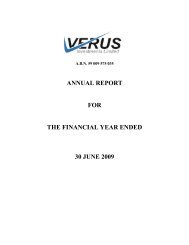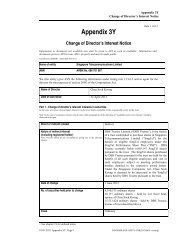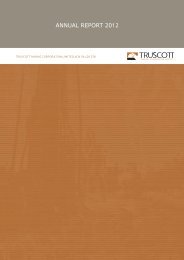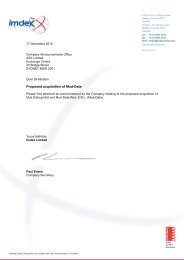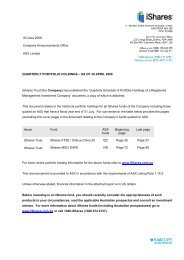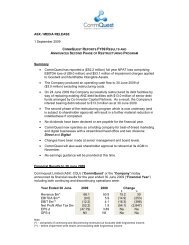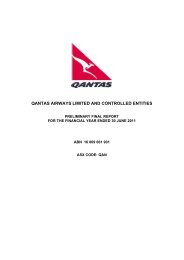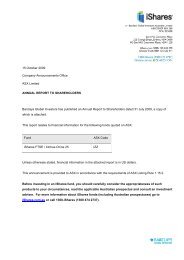ASX ANNOUNCEMENT Bega Cheese Limited ... - Open Briefing
ASX ANNOUNCEMENT Bega Cheese Limited ... - Open Briefing
ASX ANNOUNCEMENT Bega Cheese Limited ... - Open Briefing
Create successful ePaper yourself
Turn your PDF publications into a flip-book with our unique Google optimized e-Paper software.
Financial Statements<br />
Year Ended 30 June 2011<br />
Notes to the Financial Statements (cont.)<br />
i. Business Combinations<br />
The acquisition method of accounting is used to account for all business combinations, regardless of whether equity<br />
instruments or other assets are acquired. The consideration transferred for the acquisition of a subsidiary comprises the<br />
fair values of the assets transferred, the liabilities incurred and the equity interests issued by the Group. The<br />
consideration transferred also includes the fair value of any contingent consideration arrangement and the fair value of<br />
any pre-existing equity interest in the subsidiary. Acquisition-related costs are expensed as incurred. Identifiable assets<br />
acquired and liabilities and contingent liabilities assumed in a business combination are, with limited exceptions,<br />
measured initially at their fair values at the acquisition date. On an acquisition-by-acquisition basis, the Group<br />
recognises any non-controlling interest in the acquiree either at fair value or at the non-controlling interest’s proportionate<br />
share of the acquiree’s net identifiable assets.<br />
The excess of the consideration transferred the amount of any non-controlling interest in the acquiree and the<br />
acquisition-date fair value of any previous equity interest in the acquriee over the fair value of the Group’s share of the<br />
net identifiable assets acquired is recorded as goodwill. If those amounts are less than the fair value of the net<br />
identifiable assets of subsidiary acquired and the measurement of all amounts has been reviewed, the difference is<br />
recognised directly in profit or loss as a bargain purchase.<br />
Where settlement of any part of cash consideration is deferred, the amounts payable in the future are discounted to their<br />
present value as at the date of exchange. The discount rate used is the entity’s incremental borrowing rate, being the<br />
rate at which a similar borrowing could be obtained from an independent financier under comparable terms and<br />
conditions.<br />
j. Impairment of Assets<br />
Goodwill and intangible assets that have an indefinite useful life are not subject to amortisation and are tested annually<br />
for impairment or more frequently if events or changes in circumstances indicate that they might be impaired. Other<br />
assets are tested for impairment whenever events or changes in circumstances indicate that the carrying amount may<br />
not be recoverable. An impairment loss is recognised for the amount by which the asset's carrying amount exceeds its<br />
recoverable amount. The recoverable amount is the higher of an asset’s fair value less costs to sell and value in use.<br />
For the purposes of assessing impairment, assets are grouped at the lowest levels for which there are separately<br />
identifiable cash inflows which are largely independent of the cash inflows from other assets or groups of assets (cash<br />
generating units). Non financial assets other than goodwill that suffered an impairment are reviewed for possible<br />
reversal of the impairment at each reporting period.<br />
Where an impairment loss subsequently reverses, the carrying amount of the asset (cash generating unit) is increased to<br />
the revised estimate of its recoverable amount, but only to the extent that the increased carrying amount does not<br />
exceed the carrying amount that would have been determined had no impairment loss been recognised for the asset<br />
(cash generating unit). The reversal of an impairment loss is recognised immediately in income unless the relevant<br />
asset is carried at fair value, in which case the reversal of the impairment loss is treated as a revaluation increase.<br />
k. Cash and Cash Equivalents<br />
For the purpose of presentation in the statement of cash flows, cash and cash equivalents includes cash on hand,<br />
deposits held at call with financial institutions, other short term, highly liquid investments with original maturities of three<br />
months or less that are readily convertible to known amounts of cash and which are subject to an insignificant risk of<br />
changes in value.<br />
l. Trade Receivables<br />
Trade receivables are recognised initially at fair value and subsequently measured at amortised cost using the effective<br />
interest method, less provision for impairment. Trade receivables are generally due for settlement within 30 days.<br />
Collectability of trade receivables is reviewed on an ongoing basis. Debts which are known to be uncollectible are<br />
written off by reducing the carrying amount directly. An allowance account (allowance for impairment of receivables) is<br />
used when there is objective evidence that the Group will not be able to collect all amounts due according to the original<br />
terms of the receivables. Significant financial difficulties of the debtor, probability that the debtor will enter bankruptcy or<br />
financial reorganisation, and default or delinquency in payments (more than 30 days overdue) are considered indicators<br />
that the trade receivable is impaired. The amount of the impairment allowance is the difference between the asset's<br />
carrying amount and the present value of estimated future cash flows, discounted at the original effective interest rate.<br />
Cash flows relating to short term receivables are not discounted if the effect of discounting is immaterial.<br />
The amount of the impairment loss is recognised in profit or loss within 'administration expenses'. When a trade<br />
receivable for which an impairment allowance had been recognised becomes uncollectible in a subsequent period, it is<br />
written off against the allowance account. Subsequent recoveries of amounts previously written off are credited against<br />
other expenses in profit or loss.<br />
<strong>Bega</strong> <strong>Cheese</strong> <strong>Limited</strong> 2011 Annual Report 34



